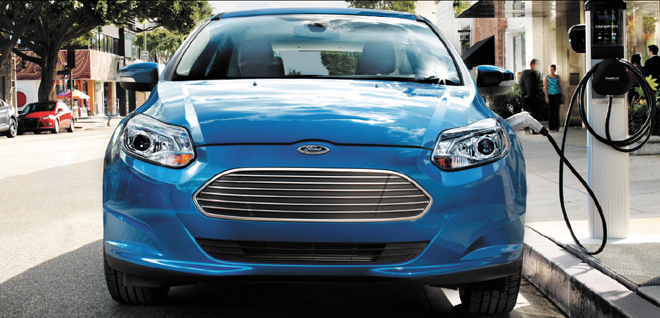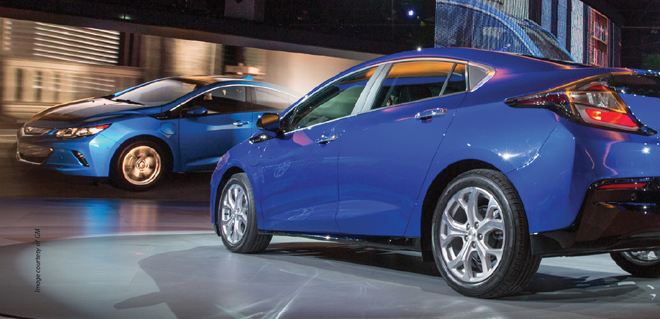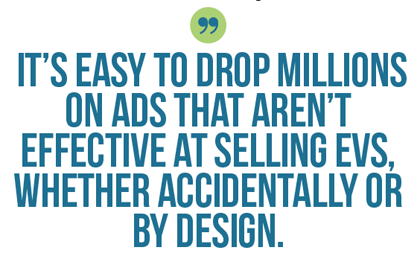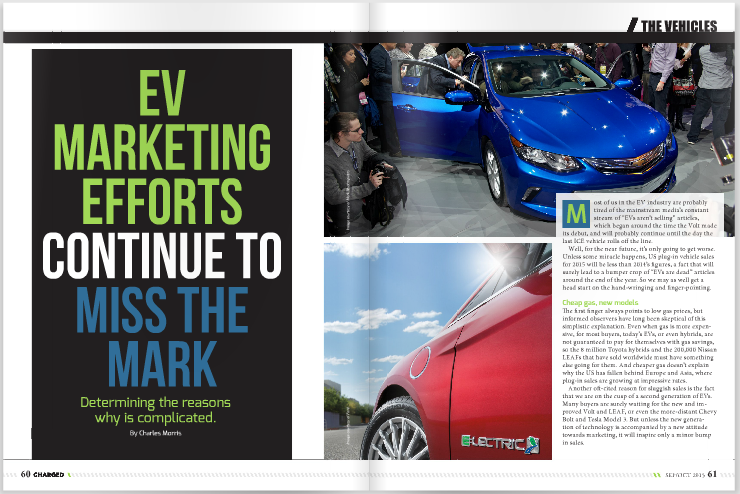Most of us in the EV industry are probably tired of the mainstream media’s constant stream of “EVs aren’t selling” articles, which began around the time the Volt made its debut, and will probably continue until the day the last ICE vehicle rolls off the line.
Well, for the near future, it’s only going to get worse. Unless some miracle happens, US plug-in vehicle sales for 2015 will be less than 2014’s figures, a fact that will surely lead to a bumper crop of “EVs are dead” articles around the end of the year. So we may as well get a head start on the hand-wringing and finger-pointing.
Cheap gas, new models
The first finger always points to low gas prices, but informed observers have long been skeptical of this simplistic explanation. Even when gas is more expensive, for most buyers, today’s EVs, or even hybrids, are not guaranteed to pay for themselves with gas savings, so the 8 million Toyota hybrids and the 200,000 Nissan LEAFs that have sold worldwide must have something else going for them. And cheaper gas doesn’t explain why the US has fallen behind Europe and Asia, where plug-in sales are growing at impressive rates.
Another oft-cited reason for sluggish sales is the fact that we are on the cusp of a second generation of EVs. Many buyers are surely waiting for the new and improved Volt and LEAF, or even the more-distant Chevy Bolt and Tesla Model 3. But unless the new generation of technology is accompanied by a new attitude towards marketing, it will inspire only a minor bump in sales.
And there’s the real reason that plug-in sales are struggling. Yes, most of the major automakers are now producing at least one EV, but the marketing still isn’t there. We’re inundated with car ads – TV, radio, magazines, newspapers, billboards, online – but few of them mention EVs. And no EV-maker has yet come up with an advertising campaign that effectively conveys the pleasures of plugging in.


Of cash cows and golden geese
The OEMs’ lack of interest in selling their EVs is probably not the product of some oil-funded conspiracy – it’s simply good business sense. Auto sales have been booming for the last couple of years, and carmakers are raking in record profits. Global automakers produced almost 90 million vehicles in 2014, the fifth year in a row of healthy increases. During the first three quarters of 2015, light vehicle sales in the USA increased again, by 5%. GM’s profits have set new records every quarter so far this year. And automakers tend to earn their highest margins on trucks and SUVs. Some analysts estimate that GM makes more than $10,000 in profit on each pickup.


Given these figures, there’s only one sensible thing for a well-run business to do: more of precisely what they’ve been doing. Conventional wisdom says that if any innovation is needed, it would be in the area of selling even more trucks. The last thing the automakers want is to devote resources to selling EVs, on which they make less profit.


None of this is a secret, although most automakers continue to insist that they are leaders in green tech, want to leave a better world to our grandchildren, etc. At a recent Ford conference, company execs described various initiatives designed to project a hip and modern image to the younger generation, some of which involve dabbling in electrification, car-sharing and other trendy endeavors. However, they also said that the company’s top long-term marketing goal was to increase truck and SUV sales.
Other than Tesla, most automotive decision-makers seem to view EVs as an R&D project, not a potential profit center. They know electrification is coming, but they see it as a gradual shift that will take place over decades. Anticipating only modest sales of their plug-in models, they commit to producing only modest quantities, so the narrative of EVs as a niche product becomes a self-fulfilling prophecy.
Not cheaper: better!
As Elon Musk pointed out when he explained why Tesla wasn’t interested in selling through traditional dealers, really selling EVs requires explaining why they are better than ICE vehicles, which some dealers and automakers will see as “cannibalizing” their existing highly lucrative business.
The automakers have failed to inspire consumers with any desire to go electric. We EV insiders look at the 2016 Volt and see a marvel of high-tech engineering, a huge step forward. But Joe Car Buyer looks at the Volt, and sees a car that looks like the Cruze, with better gas mileage, at double the price.
Any company that really wants to sell substantial amounts of EVs is probably going to have to establish a new stand-alone brand, with separate dealerships (BMW has made some exploratory moves in this direction). And these dealers are going to have to say to customers, “Do not buy a gas-powered vehicle. Pay the higher price for an EV, because it’s a better car.”
Disruption in low gear
Given the simple economic facts, this isn’t likely to happen any time soon. Does that mean that the saga of electrification will see the dinosaurs of Detroit go the way of extinct species like Kodak and Blockbuster? Will Tesla, Apple and a crop of China-funded startups elbow them away from the lunch counter? After all, this is pretty much the scenario that has played out in most disrupted industries, from computing to telephony to music.
This may sound great to EV boosters, but there are a couple of problems with this scenario. Cars are big heavy tangible items that need brick and mortar factories to build them, and massive amounts of money and time to design, develop and service them. A healthy dose of old-school auto industry conservatism may be required to build vehicles that last for 10 to 20 years. There’s a good reason it seems to take forever for the OEMs to design a new model – they do exhaustive testing to make sure things don’t fall apart 50,000 miles down the road. This is a lesson Tesla is learning the hard way – Consumer Reports recently said that Model S’s long-term reliability doesn’t measure up to its performance.
Software and innovative business processes will have a greater impact on the auto industry than most people now imagine, but there are some risky Silicon Valley principles that don’t translate well to the world of tires, windshields and all that bent metal. Any disruption of the auto industry will surely be a long epic feature, not a 6-second Vine video.
You can lead a horseless carriage to water…
Fortunately or unfortunately, depending on your perspective, automakers are not free to run their businesses based solely on the bottom line. Governments tightly regulate almost every aspect of the business, and in most of the biggest markets (China, Europe, California), regulations, specifically those related to emissions, are getting tougher every year. If OEMs want to keep selling gas-guzzling trucks, SUVs and sports cars, they’ll have to sell more and more ZEVs (another, arguably better option would be to electrify the trucks, SUVs and sports cars).
But this brings us back to marketing. Governments can and do force automakers to produce EVs, but they can’t force consumers to buy them (no, not even in China). The burden of persuading buyers with good products and great marketing remains on the automakers, and the Madison Avenue firms they employ. We industry observers had our interests piqued when GM and Ford recently released new TV ad campaigns for their plug-ins. However, the interest quickly turned to disappointment as we learned more about the efforts.


It was particularly puzzling that Ford chose to start running TV ads for the Focus Electric, which went on sale in early 2012. Yes, these are the very first TV ads for the EV, according to Ford’s PR firm Ogilvy. It seems to be a substantial ad buy – Ogilvy declined to talk about budgets, but the firm told us that the TV ads will run in eight major US metro areas on a wide variety of different types of programs, and print ads will run in newspapers and several categories of magazines.
To get a better idea of what Ford is up to here, we talked to EV industry expert Chelsea Sexton, who always seems to have the inside scoop. She believes that the new spot is nothing more than a “halo” ad, meant to establish Ford’s green credentials so it can get on with the business of selling customers the trucks and SUVs that they really want. “If there’s anything we know about the history of EV advertising, it’s that not all of it is meant to actually sell EVs,” said Sexton.


This theory is supported by the fact that the TV ad is actually half an ad – a fifteen-second spot that runs together with ads for other Ford vehicles – and it’s running in cities that are mostly not EV sales areas. It’s really just part of a larger Ford campaign called By Design.
GM’s recent efforts to promote the new Volt are, at least, more substantial marketing attempts. The company has produced a series of videos that debuted in long form on the internet, and were shortened for broadcast. EV proponents, however, were not thrilled to find that Chevrolet decided to present the Volt’s PHEV system as superior to other forms of electrification, with head-to-head attacks on the LEAF and the Prius.
One ad attacks the Nissan LEAF, showing people stuck between floors in an elevator, and drawing an analogy to what could happen if a pure EV runs out of charge [Editor’s note: This ad has now been removed from Chevrolet’s YouTube page].
A second ad cracks on the Toyota Prius, comparing its nickel metal hydride battery technology to the more modern lithium-ion batteries used in the Volt, and implying that the former present some sort of disadvantage for consumers.
“We’re going to go head-to-head with LEAF and Prius,” said Chevrolet Global Chief Marketing Officer Tim Mahoney at the San Francisco press launch. “The ads allow Chevrolet to talk in one way and they allow Chevrolet’s personality to come through. We’re going to be taking more risks.”
Has Chevrolet forgotten that it also sells non-plug-in hybrids (Malibu Hybrid) and non-range-extended EVs (Spark EV and Bolt EV)? Given the amount of hype the company is building for the Bolt EV, playing the range-anxiety card to sell Volts seems like a strategy they may soon regret.
Where’s the beef?
In September, two German organizations (the Roland Berger Automotive Competence Center and the fka Research Institute) published a study called the E-Mobility Index, which clearly articulated this problem. The report finds that, while there are certainly other factors, one of the most important reasons that average market share for plug-ins worldwide is stagnating at below 1% is a failure of marketing by the OEMs.


“There’s very little, if any, promotion of electric cars going on,” reads the report. “It’s no wonder potential customers are not getting interested in them. The lack of coherent sales concepts is partly responsible for the weak sales figures.”
Finding good data on specific marketing efforts is nearly impossible. The automaker’s aren’t quick to share how much they spend on ads, what products they focus on, and in what markets. Even with hard numbers, discerning what’s actually going on would be difficult. “There are so many layers of both actual truth and motive,” said Chelsea Sexton.
The automakers are being forced to sell ZEVs in certain markets, and at least some of them are doing so unwillingly – the continued lobbying efforts to have those requirements relaxed make that obvious. So there’s still a real concern that some may be trying to sabotage EV sales in an effort to have the mandates loosened or overturned.


Sexton points out that, beginning in 2018, the California Air Resources Board ZEV program will require automakers to actually sell EVs, not just offer them. “We will see some companies trying sincerely to do that, and some putting a lot of effort behind looking like they tried,” she said.
Another problem is that the category of plug-in cars is so new that each model brings challenges of marketing in completely uncharted territory. “Even the companies that are ‘sincere’ don’t necessarily know how to do this well,” said Sexton. “Add in the fact that most pass the job to agencies, who are even less in touch with the market we’re aiming at, and it all gets murky fast. And in that environment, it’s easy to drop millions on ads that aren’t effective at selling EVs, whether accidentally or by design.”
This article originally appeared in Charged Issue 21 – September/October 2015. Subscribe now.



















































